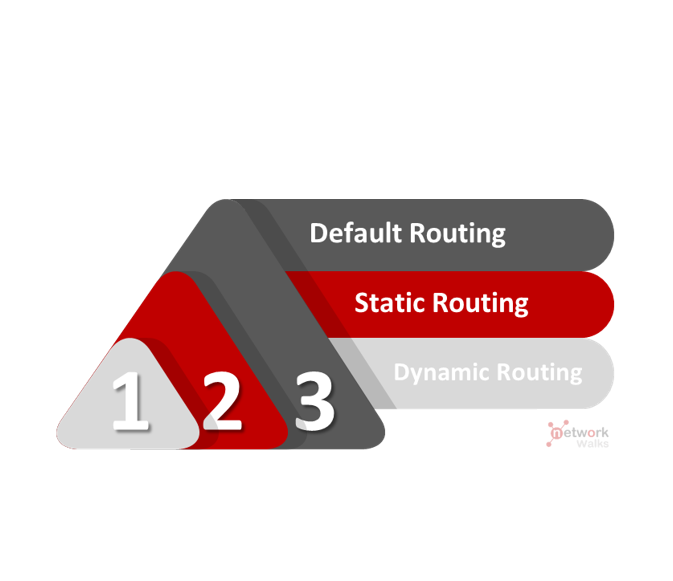
What is Static Routing?
It is a type of fixed routing where path selection & routing is controlled manually by network admin.
What are the properties of Static Routing?
Static routing has following properties:
- AD (Administrative Distance) of a Static route is 1
- Path selection & routing is manually controlled by the network administrator
- Static Routes are always preferred over Dynamic Routing protocols like OSPF/RIP/BGP
- Static Routes are less resource & BW intensive
- They are not fault tolerant (paths are always fixed)
- They are not practical for large networks
How many types of Static Routes do we have?
The following are the types of static routes:
- Standard Static Route: Normal static routes are implemented when connecting to a specific remote network
- Default Static Route: A static route with 0.0.0.0/0 as the destination IP address (a route that matches all packets & also called as default GW)
- Other types: Summary Static Route, Floating Static Route (Backup routes)
What are the advantages of Static Routing?
Below are some of the advantages of static routing:
- It is less resource & BW intensive (there is no overhead in terms of CPU usage of router)
- It has a Small Routing Table
- The Admin has more control in terms of best path selection
- It does not require advanced knowledge/skills by the Admin
- It is easy to implement
- It is secure as the network admin chooses to allow routing access to specific networks only

What are the disadvantages of Static Routing?
- It is suitable for small network.
- The administrator needs to know the whole internetwork.
- It is not a scalable option (every change needs to be manually carried out on each router in the internetwork).
- There’s no fault tolerance (if a link fails, it is not auto routed to available paths).
- Does not support overloading.
What is Default Routing?
It is a type of routing where all IP requests are sent to a single, fixed Default Gateway.
What are the characteristics of a Default Routing?
Default Routing has following characteristics:
- AD (Admin Distance) of Default Static route is 255 (lowest priority in Routing table)
- Default route is denoted by 0.0.0.0/0 for IPv4 & ::/0 in IPv6
- Default Routes handle traffic for unknown destinations
- All IP requests are sent to a single fixed Default Gateway
- They are not fault tolerant (not practical for large networks)
- They are less resource & BW intensive
- Default routing is useful when dealing with a network with a single exit point
What are the advantages/merits of Default Routing?
The following are the advantages or merits of Default Routing:
- It is less resource intensive (there is no overhead in terms of CPU usage of router).
- Requires less bandwidth intensive between routers.
- It has a Small Routing Table.
- Allows connectivity to remote networks even if they are not in the routing table at all.
- It is useful when a bulk of destination networks have to be routed to a single next-hop device.
- There’s no advanced knowledge or skills required by the Admin.
What are the disadvantages/demerits of Default Routing?
The following are the disadvantages or demerits of Default Routing:
- There’s no fault tolerance (if the link to Default Gateway goes down, it is not auto routed to available paths).
- It does not support load balancing.
What is the metric of Static route?
It is important to note that static route does not calculate metric. In routing table metric of static route shows 0.
What is the AD (Admin Distance) value of Static route?
The default route AD (Admin Distance) value of Static route is 1. The default AD value is always 1, whether the route is configured with the outgoing interface or the next hop IP.
What is Floating Static route?
It is a static route that is configured with a higher Admin Distance (AD), which can be used as a backup for other routes with a lower Admin Distance (AD).
What is a Static host route?
It is a route that is configured for a single destination IP.
What does 0.0.0.0/0 Signifies?
0.0.0.0/0 is the route where any IP address can fall from range 0.0.0.0 to 255.255.255.255
What is AD value and Metric default Static route?
The AD (Admin distance) value of a static route is one (1). And the metric value is zero (0).
What is the gateway of last resort?
A gateway of last resort is the path or route used by a router when no other known path exists to forward an IP packet.
What is the method of Load balancing in Static route?
It occurs when two similar static routes are on the same router but have distinct next hops.
What is the Syntax for Static Routing?
R1(config)#ip route <destination network> <subnet mask> <next hop IP or exit interface>
What is Hop Count?
Hop count is the number of routers through which the packets must pass from the source to the destination network.
-End-
You might also be interested in our free Online Quizzes on all IT topics including Cisco CCNA, Cyber Security, Python Programming, Linux & Ethical Hacking:
You can also view free study notes (Cheat sheets) for long term memory on Static & Default Routing Interview Questions:
Follow our Facebook Page & YouTube Channel for more updated Cheatsheets & Quizzes:
Static & Default Routing Interview Questions
